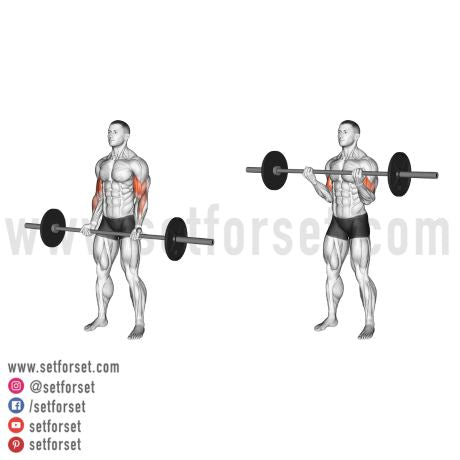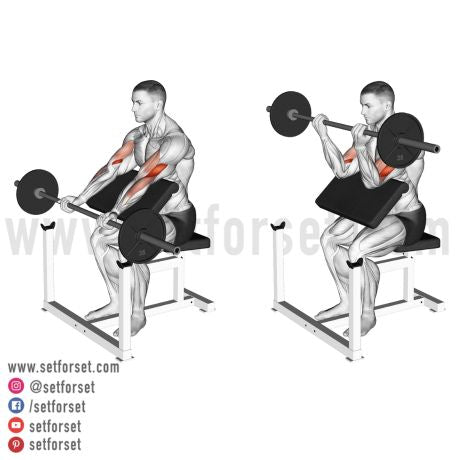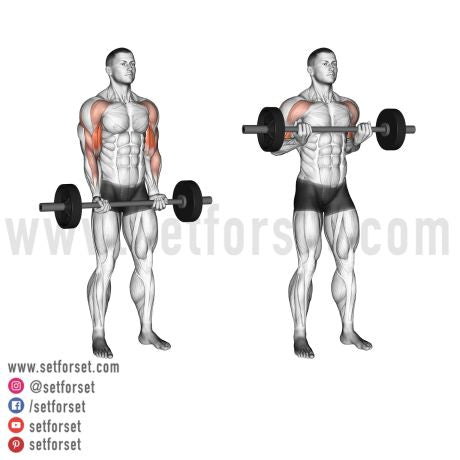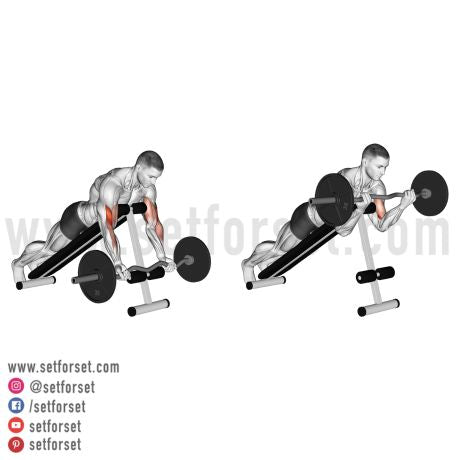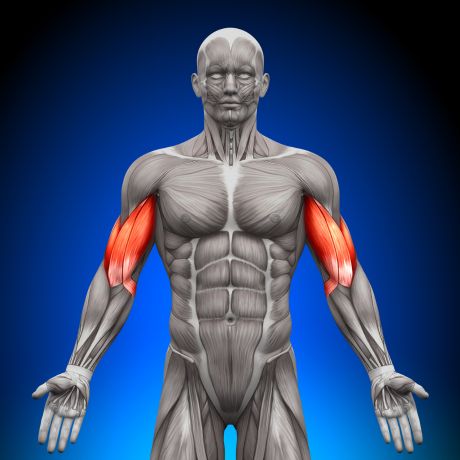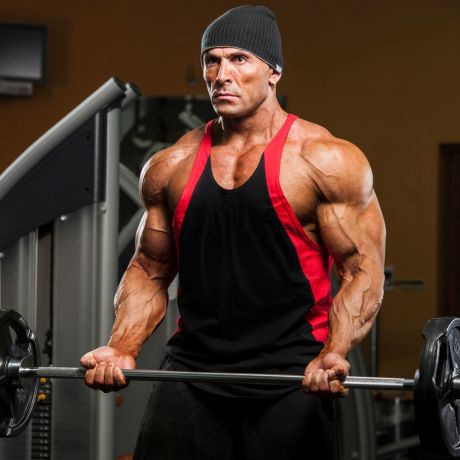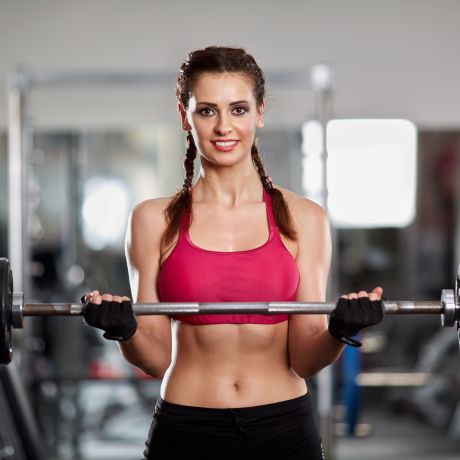When it comes to building impressive biceps, nothing beats the effectiveness of barbell exercises. Barbell movements allow you to lift heavy weights, targeting the biceps from various angles for optimal muscle growth. Whether you’re a seasoned lifter or a beginner looking to sculpt stronger arms, incorporating these five best barbell bicep exercises into your routine can help you pack on mass and achieve those coveted gains.
1. Barbell Curl:
The barbell curl is a classic bicep exercise that primarily targets the biceps brachii muscle. To perform this exercise, stand with your feet shoulder-width apart, grip a barbell with an underhand grip (palms facing upwards), and curl the barbell towards your shoulders while keeping your elbows stationary. Lower the weight back down under control to complete one repetition. Aim for 3-4 sets of 8-12 reps to stimulate muscle growth effectively.
2. Reverse Grip Barbell Curl:
The reverse grip barbell curl shifts the focus onto the brachialis muscle, which lies underneath the biceps. This variation helps add thickness to your arms, contributing to a more aesthetic appearance. To execute the reverse grip curl, grab the barbell with an overhand grip (palms facing downwards), and curl the weight towards your shoulders while maintaining proper form. Perform 3-4 sets of 8-12 reps with moderate to heavy weights to maximize muscle stimulation.
3. Standing Barbell Preacher Curl:
The standing barbell preacher curl isolates the biceps by eliminating any momentum or cheating movements, making it an excellent exercise for targeting the peak of the biceps. Set up a preacher bench or use a squat rack with an adjustable safety bar. Position yourself against the angled pad, grip the barbell with an underhand grip, and curl the weight upwards, focusing on squeezing the biceps at the top of the movement. Aim for 3-4 sets of 8-12 reps with controlled movements to feel the burn in your biceps.
4. Wide-Grip Barbell Curl:
The wide-grip barbell curl emphasizes the outer portion of the biceps, helping to create width and thickness in your arms. Grab the barbell with a grip slightly wider than shoulder-width apart, and perform curls while keeping your elbows tucked in and your upper arms stationary. Focus on contracting the biceps throughout the movement to maximize muscle engagement. Incorporate 3-4 sets of 8-12 reps into your workout routine for well-rounded bicep development.
5. Zottman Curl:
The Zottman curl is a versatile exercise that targets both the biceps and forearms, promoting balanced muscle growth and forearm strength. Begin by holding a barbell with an underhand grip (palms facing upwards), curl the weight towards your shoulders, then rotate your wrists at the top of the movement to switch to an overhand grip (palms facing downwards), and lower the weight back down. Perform 3-4 sets of 8-12 reps to challenge your biceps and forearms effectively.
Conclusion:
Incorporating these five best barbell bicep exercises into your workout routine can significantly enhance your arm development and help you achieve your muscle-building goals. Remember to maintain proper form, focus on the mind-muscle connection, and progressively overload your muscles with heavier weights over time. With dedication and consistency, you’ll be on your way to packing on mass and sculpting impressive biceps that command attention.
Aside from chest day, is there any day better than arm day? Sure, it’s
great to bench press, but little can compare to a nice arm pump. The bicep
muscles are arguably the most important muscle group for aesthetics, as
nothing beats pumped-up bicep muscles bulging out of your tee shirt. One of
the best ways to gain size and strength in the biceps is with barbell
exercises. Science has shown that free weights are more effective than
machines for muscle growth, so barbells are essential, regardless of the
muscle group or workout routine. In this article, we will teach you the five
best biceps exercises using a barbell, which are all bicep curl
variations.
vist
Table of Contents
- 5 Best Bicep Barbell Exercises
- Other Bicep Exercises
- Anatomy of the Biceps
- Programming Tips
5 Best Bicep Barbell Exercises
In this section, we will explain the best biceps exercises to take your
bicep workout to the next level and help those arm muscles grow to another
level. For all of the exercises, you can use a regular barbell and add
weight or a fixed-weight barbell.
1. Standing Barbell Curl
Just as the squat is the king of leg exercises and bench press is the king
of chest exercises, the
barbell biceps curl
is the king of biceps exercises. The barbell bicep curl is a variation of
the classic dumbbell curl, primarily targeting the biceps brachii. It also
involves the brachialis, brachioradialis, and various forearm muscles. The
forearm muscles include the flexor and extensor muscles to help stabilize
the wrist and maintain a strong grip.
Instructions:
- Stand tall with your feet shoulder-width apart.
- Grab the barbell with an underhand (palms facing out) grip, hands slightly
wider than shoulder-width apart. Keep your arms straightened so the barbell
hangs near your thighs. - To help keep the body stable, keep your elbows close to your body, shoulder
blades pulled back, and core engaged. - Exhale your breath and slowly curl the barbell upward towards your chest by
flexing the elbow. Keep your entire body and upper arms steady, moving only
your forearms. - Squeeze the biceps as much as possible at the top of the lift to feel the
contraction. Be sure to maintain control of the weight without using your
body for momentum, like by swaying the back. - Inhale while slowly lowering the barbell back down to the starting position.
Focus on the stretch of this negative portion of the lift as well. Ensure
you fully extend your arms to get the maximum range of motion. - Repeat for reps anywhere in the five to twelve range.
2. Barbell Preacher Curl
Another excellent barbell biceps exercise is the barbell
preacher curl. The barbell preacher curl primarily targets the biceps brachii, with
secondary work to the brachialis, brachioradialis, and forearm muscles. The
exercise requires a preacher bench, or you can create one using an incline
bench.
Instructions:
- Adjust the preacher bench so your body fits, so your chest is pushed against
the top of the pad, and your triceps are firmly placed on the angled
pad. - While sitting (or kneeling), grab the barbell with an underhand or supinated
grip and hands slightly wider than shoulder-width apart. Your arms should be
fully extended. - Exhale and slowly curl the weight toward your forehead by flexing your
elbows. Focus on squeezing the muscle at the top of the contraction. Keep
your upper arms still, and only use your forearms during the lift. - Keep your shoulders pulled back, core tight, and elbows planted against the
pad throughout the motion. - Inhale and slowly lower the weight as far as possible without locking out
our elbows. Focus on feeling the negative portion while you lower the
barbell. - Repeat for desired reps.
3. Barbell Drag Curl
The barbell drag curl is a lesser-known movement than the standard or
preacher curl, but it is just as effective at building biceps muscle. The
barbell drag curl is a variation of the straight barbell curl, where the
barbell is dragged along the torso rather than being curled upward in a
linear motion like a normal barbell curl. Even though it is a shorter range
of motion, it removes momentum from other muscles like the shoulders to
place more time under tension on the biceps. It also primarily targets the
biceps brachii, with secondary work to the brachialis, brachioradialis, and
forearm muscles.
Instructions:
- Stand tall with your feet shoulder-width apart.
Grab the barbell with a supinated grip, with your hands against your
upper thighs, slightly closer than a regular curl. Keep your arms
straightened so the barbell hangs near your thighs.
- You can also use an overhand grip, but underhand is the standard and more
comfortable. - Keep your elbows close to your body, shoulders pulled back, and core engaged
to help keep the body stable. - Exhale and slowly start the curl by flexing your elbows and dragging the
barbell along your torso upwards toward your shoulders. The bar should be
touching your body throughout. - Squeeze the biceps at the top of the curl to feel the contraction. The lift
should be controlled, so avoid swinging the body or other movements to
generate momentum. - Inhale and slowly lower the barbell to the starting position. During the
negative portion, focus on keeping the tension in the biceps. - Repeat for desired reps.
4. Barbell Spider Curl:
Another great barbell biceps exercise is the barbell
spider curl, a unique variation with a preacher-like movement. Like all the other curl
variations, spider curls primarily work the biceps, with accessory work to
the brachialis, brachioradialis, and forearm muscles. The angle of the body
allows for a greater range of motion and creates shoulder flexion. Exercises
like this with shoulder flexion put more emphasis on the short head of the
biceps. The shoulder flexion puts the long head in a disadvantageous
position, so the short head takes the bulk of the lift.
Instructions:
- Set up an incline bench to either 30 or 45 degrees.
- Stand so that you are facing the inclined bench, with one foot on each side
of the seat on the bench. Lean forward so that your chest is against the
inclined padded bench. - Have someone hand you the barbell, or take your set-up position holding the
barbell with an underhand grip, hands slightly outside your shoulders. Your
arms should be fully extended straight down so that the barbell is below
your shoulders, but keep a slight bend in the elbows to avoid locking them
out. - Keep your chest against the bench pad at all times and your feet flat on the
floor. Exhale and slowly curl the bar upwards towards your shoulders by
flexing the elbow. Make sure you keep your elbows and triceps against the
pad throughout. - Squeeze the biceps at the top of the curl to get the maximum muscle
contraction. - Inhale and slowly lower the barbell back down to the starting position, but
avoid locking out your elbows. Focus on the biceps time under tension as you
slowly lower the bar. - Repeat for reps.
5. Reverse Barbell Curl:
The
reverse barbell curl
is a bicep curl variation where you use a reverse grip so that your palms
are facing the ground while performing barbell curls. The barbell reverse
curl primarily targets the brachioradialis, which is technically not part of
the biceps muscles but is important for building biceps strength. It also
works the biceps, the brachialis, and other forearm muscles secondarily.
This exercise should be done towards the end of the biceps workout, after
the straight barbell curl and other bicep exercises, since it primarily
focuses on the forearms. If your forearms and brachioradialis are
pre-exhausted, your biceps training will suffer because they will give out,
even though you have the biceps strength.
Instructions:
- Stand tall with your feet shoulder-width apart.
- Grab the barbell with an underhand grip, with your hands in line with your
feet and shoulders. Keep your arms straightened so the barbell hangs near
your thighs. - Keep your elbows tight next to your body, shoulder back, and core engaged.
- Exhale and curl the barbell upward towards your shoulders by flexing the
elbow. Focus on squeezing the brachioradialis to lift the weight. - Just like a normal biceps curl, maintain control of the weight without using
your body. - Inhale and slowly lower the barbell back down to the starting position.
Fully extend your elbows without locking them. - Repeat for reps.
Other Biceps Exercises
The five barbell bicep exercises above should be the staple of all biceps
workouts, but it’s important to use isolation exercises to maximize biceps
muscle growth.
Some great bicep isolation exercises include:
Isolation bicep exercises should be performed at the end of the workout as
a way to target a specific head of the biceps, upper arms, or forearms,
especially if you are doing a complete arm workout (rather than just
biceps). These types of bicep exercises should be done at a higher
repetition range, ideally in the ten to fifteen range, using a moderate
weight that can be completed in a controlled manner with a full range of
motion.
Anatomy of the Biceps
The biceps brachii is one of the two main muscles of the upper arm along
with the triceps. The origin of the word is derived from the Latin words
“bi” and “ceps,” which means “two heads.” This is because there are two
biceps heads, the long head and the short head.
- Long head– The
long head
of the biceps starts from the supraglenoid tubercle of the scapula (shoulder
blade), which is just above the shoulder joint. The long head is the top
portion of the biceps that someone might touch as you flex or the peak of
the muscle. - Short head– The
short head
of the biceps starts from the coracoid process of the shoulder blade, which
is on the front of the scapula close to the shoulder joint. The short head
is the portion you see below the long head, which runs in towards the
armpit.
The two heads combine to form the biceps brachii, connecting the upper arm
to the radius bone on the forearm.
Functions:
- Elbow flexion: The main purpose of the biceps is literally
flexing…of the elbow joint. The bicep’s primary function is flexion of the
elbow joint to allow the hands to move closer to the shoulders. - Forearm rotation: The biceps also assist in the rotation of
the palm upward or forward, which is called forearm supination. - Stabilizer: The last primary purpose of the biceps is
to stabilize the shoulder joint. This mainly applies to the long head of the
biceps because it starts at the scapula. Stabilization is especially
important for overhead movements or lifting heavy items.
Accessory Muscles
Every exercise that targets the biceps also involves the brachialis and
brachioradialis because these muscles work in unison with the biceps during
elbow flexion. Although they aren’t technically part of the same muscle
group, they are closely related.
- Brachialis: The
brachialis, a muscle under the biceps, is the strongest elbow flexor. It starts at
the bottom of the humerus (upper arm bone) and connects to the ulna bone of
the forearm. - Brachioradialis: The brachioradialis is the long
muscle on the lateral (outer) side of the forearms that helps flex the
elbow, especially from a semi-pronated or neutral grip. You can see this
muscle flexed during any curling exercise.
Forearm muscles are divided into two categories:
- Anterior forearm flexors
- Posterior forearm extensors
Forearm flexors are on the palm side (anterior) of the arm and help to flex
the wrist and fingers, as well as forearm pronation. The forearm extensors
are on the back of the forearm (posterior) and help to extend the wrist and
fingers, as well as forearm supination. All of these forearm muscles play a
key role in maintaining grip strength and stabilizing the
wrists during the barbell curl and other curl variations.
Programming Tips
- Barbell exercises first: Research has shown that training
large muscle groups with compound movements is more effective first, then
progressing to smaller muscles.¹
An example is training the forearms last after your biceps
workout. This is also why you should do barbell exercises first, then
progress to machines or isolation movements, like the dumbbell curl. You
want your muscles to be fresh for the most important exercises. - Form > Weight: While true for any muscle group,
it’s especially important when training biceps to focus on form rather than
heavy weights. You will make significantly better progress if you use
lighter weights with a full range of motion in a controlled
manner rather than using heavier weights with bad form. The biceps are small
muscles; they don’t need extreme resistance to grow. - Hand position: Hand positioning is crucial when training
any muscle group, especially for a bicep exercise. Studies have shown
significantly more muscular activity of the brachioradialis during elbow
flexion with an overhand (pronated) grip compared to a neutral or underhand
(supinated) grip.²
Any bicep curl with an overhand (pronated) grip primarily works the short
head, while underhand targets the long head of the biceps. Exercises like
the hammer curl that utilize a neutral grip (palms facing each other)
primarily hit the brachialis.
Outro
Biceps training is essential for building arm muscles and overall
upper-body development. Depending on your routine split, you likely do the
bicep workout as part of an arm workout or upper body day. Regardless of
when you train, your bicep workout should be centered around the barbell
curl and other barbell workouts. Some of the most effective biceps exercises
include the barbell curl, preacher curl, drag curl, spider curl, and reverse
barbell curl.
If you want bigger biceps, add these exercises to your biceps workout and
perform the compound barbell lifts first, then isolation exercises at the
end to sculpt lacking areas of the upper arms. Focus on having perfect form
with a full range of motion where you can squeeze the contraction as much as
possible rather than ego lifting with bad form. Lastly, pay attention to
your hand positions and change them occasionally to build a complete bicep
muscle.
Conclusion:
Incorporating these five best barbell bicep exercises into your workout routine can significantly enhance your arm development and help you achieve your muscle-building goals. Remember to maintain proper form, focus on the mind-muscle connection, and progressively overload your muscles with heavier weights over time. With dedication and consistency, you’ll be on your way to packing on mass and sculpting impressive biceps that command attention.
Top References
Sheikholeslami-Vatani, Dariush, et al. “Comparison of the Effects of
Resistance Exercise Orders on Number of Repetitions, Serum IGF-1,
Testosterone and Cortisol Levels in Normal-Weight and Obese Men.” Asian
Journal of Sports Medicine, vol. 7, no. 1, 1 Mar.
2016, https://doi.org/10.5812/asjsm.30503.Kleiber, Tim, et al. “Muscular Coordination of Biceps Brachii and
Brachioradialis in Elbow Flexion with Respect to Hand Position.”
Frontiers in Physiology, vol. 6, 6 Aug. 2015,www.ncbi.nlm.nih.gov/pmc/articles/PMC4526813/,https://doi.org/10.3389/fphys.2015.00215.
